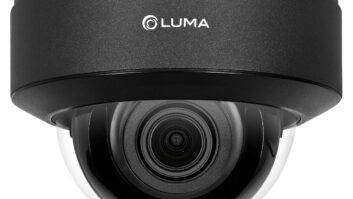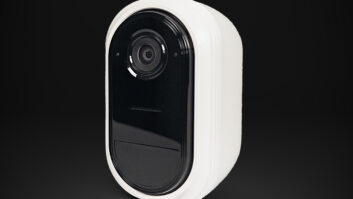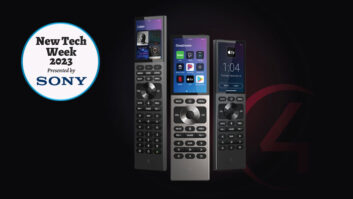I like knowing what I’m getting myself into ahead of time. I guess that’s probably true for most people, but consider the weird position I’m in with Residential Systems: I’m not an actual working systems integrator by trade; I’m a journalist. And yet, when I review a product in these pages, I have to wear an integrator’s hat. Sometimes that means going through intensive weeklong training courses. Sometimes it means spending hours on the phone with dealer support, trying to figure out how a product ticks. And sometimes it means throwing caution to the wind and just winging it. Such was the case when I tried out SnapAV’s IP surveillance system.

SnapAV’s indoor cube camera features contact closures and trigger outputs built into the chassis, enabling recording based on events such as doors opening, in addition to motion sensing. I’ve installed and reviewed security cameras before, of course, but entirely in isolation–one camera, one network connection, one device to integrate into my Control4 system. So when SnapAV suggested going whole-hog with a Wirepath 300-Series 9 Channel NVR and two network-connected cameras (one of the indoor variety; the other an outdoor dome with sensing capabilities up to 50 feet), I’m not even going to lie to you: I eeped a little bit. Could I venture so far outside of my comfort zone within the constraints set by a print deadline? Would my experience with setting up distributed AV and home control systems help me at all here? Could I do this right?
Fast-forward a week or so, and the answers to those questions are: I could and did. It was, but only to a point. And, maybe not, had it not been for the clear, concise documentation provided by SnapAV and the wealth of resources available on its website.
If you’re as unfamiliar with networked surveillance monitoring and recording as I was a week ago, it may be helpful if I step back and define a few terms before we go forward much further. The Wirepath Surveillance 300-Series 9 Channel NVR distributed by SnapAV is, in effect, not only a sort of central processor for IP security cameras, it’s also a full-fledged video recorder, with HDMI output capabilities and a VGA output if you’d rather use it with a computer monitor. In addition, it serves as the communications hub for the security cameras, if you just want to set up and install a standalone surveillance system without deeper integration in a home control system.
With a terabyte of disk space, the NVR has enough onboard storage to hold more than a week’s worth of video with just two cameras attached. You could extend that, of course, by residentialsystems.com setting the cameras to only record when motion is detected. You’ll reduce the storage quite a bit by adding more cameras. But there are three extra internal hard drive spaces inside, and there’s also a handy eSATA port on the back if you want to plug in an external drive.
Setup of the 300-Series 9 Channel NVR is simple and straightforward, but SnapAV makes it even more so thanks to its online resources, including all of the setup software and all of the drivers you’ll need in the event that you lose the installation disc.

The SnapAV Wirepath Surveillance 300-Series 9 Channel NVR, the IP cameras’ central processor, also doubles as a full-fledged video recorder with 1 TB of disk space, and HDMI and VGA outputs. Setting up the cameras themselves can be a little trickier, if only for the fact that you have several options as to how to connect them. The simplest and most straightforward method is Power-over-Ethernet, and I was able to test this out by robbing PoE injectors from a few of my wireless access points around the home (neither the Wirepath Surveillance 300-Series Cube IP Indoor Camera with IR nor the Wirepath Surveillance 550-Series Dome IP Outdoor Camera with IR provided by SnapAV come with power supplies, although you can order them for both through the website).
Let’s talk about the cameras in and of themselves, though, because even independent of the centralized capabilities enabled by the Wirepath NVR, these cameras are mega impressive in their own right, and not just in terms of their excellent video performance. The 300-Series Cube IP Indoor Camera, for example, is a marvel of installation flexibility, not merely due to its bite-sized construction, but also the included mounting hardware. It also features contact closures and trigger outputs built into the chassis (so you can, for example, set up recording based on doors opening, rather than just the motion sensing of the camera, and even use the camera to trigger an alarm).
The 550-Series Dome IP Outdoor Camera, by contrast, is built like that refrigerator in the last Indiana Jones movie (the one that survived the nuclear blast, if you’ve wiped that atrocity from your memory). In fact, of all the security cameras I’ve laid hands on, whether it be here at home or at trade shows, or control system training, this little Wirepath beast is, by far, the best built. What I love most about it, though, isn’t its solid construction; it’s the fact that the Ethernet connection and power port are housed on a water-tight pigtail that comes out of the body of the camera itself. So you don’t have to take the chassis apart and dig around inside to make your connections. For someone with Wookiee-sized front paws like myself, this is kind of a big deal. Strike that: this is definitely a huge deal.
One thing I learned during the setup of this system (which may be old news to those of you have a lot of experience installing IP surveillance systems, but it was very much an “ah ha!” moment for me) is just how much installation flexibility comes from the network “connectedness” of the SnapAV Wirepath components. That came in handy because, while SnapAV does provide IP drivers for a number of different control systems, the availability of said drivers isn’t universal just yet. The cameras, for example, include IP drivers for Crestron, ELAN g!, RTI, Savant, and my own favorite Control4.

The outdoor dome camera has sensing abilities up to 50 feet and has an extremely solid build. The NVR, meanwhile, is only currently supported by IP drivers for ELAN g!, RTI, and URC, with Crestron and Control4 drivers in development. Given my inexperience with such systems (especially NVRs), I did freak out a little at first and decide to forgo Control4 integration altogether. Then I realized, “wait a minute!” The communication between all of these devices is flowing through the same home network; why not just add the cameras to Control4 for remote access (which allowed me to skip the port-forwarding aspect of the NVR’s network setup) and run the NVR system independently? Effectively, the result was two discrete systems that overlapped in the middle, somewhat similarly to the way I have my Lutron RadioRA 2 and Control4 systems integrated. That worked beautifully for a couple of days, before SnapAV was kind enough to send over a beta version of its NVR driver for Control4.
The point, though, is that I’m sort of proud of myself here. I went from being a rank noob in terms of surveillance systems integration to a full-blown improviser in a couple of days. But as much as I’d love to take full credit for that, the bulk of the glory goes to SnapAV, whose wealth of clear documentation and online resources took the uncertainty right out of exploring this uncharted (for me) new territory.
866.424.4489
snapav.com
Kudos
SnapAV’s Wirepath NVR and IP surveillance cameras are beautifully built and deliver incredible design and installation flexibility, along with exceptional performance. But perhaps more importantly, the company’s support, documentation, and online resources are a par none.
Concerns
Power supplies aren’t included with the cameras, so if you can’t go the PoE route, power hardware need to be purchased separately on SnapAV’s dealer site.
Product Specs
Wirepath Surveillance 300-Series Cube IP Indoor Camera with IR
► Image sensor: 1/2.7” 2MP CMOS sensor
► Lens Type: 2.8mm Fixed Lens F2.0
► Minimum Illumination: 0.1 lux @F2.0 (IR off); 0 lux @ F2.0 (IR on)
► Shutter Speed: 1/5~1/1000
► True Day/ Night (IR Cut Filter)
► Shutter Speed: 1 / 5 ~ 1 /10,000 sec
► IR: 15.4ft
► Input/Output Ports: 1 Digital in and 1 Digital out, DC-jack, 1 Audio out, RJ45







